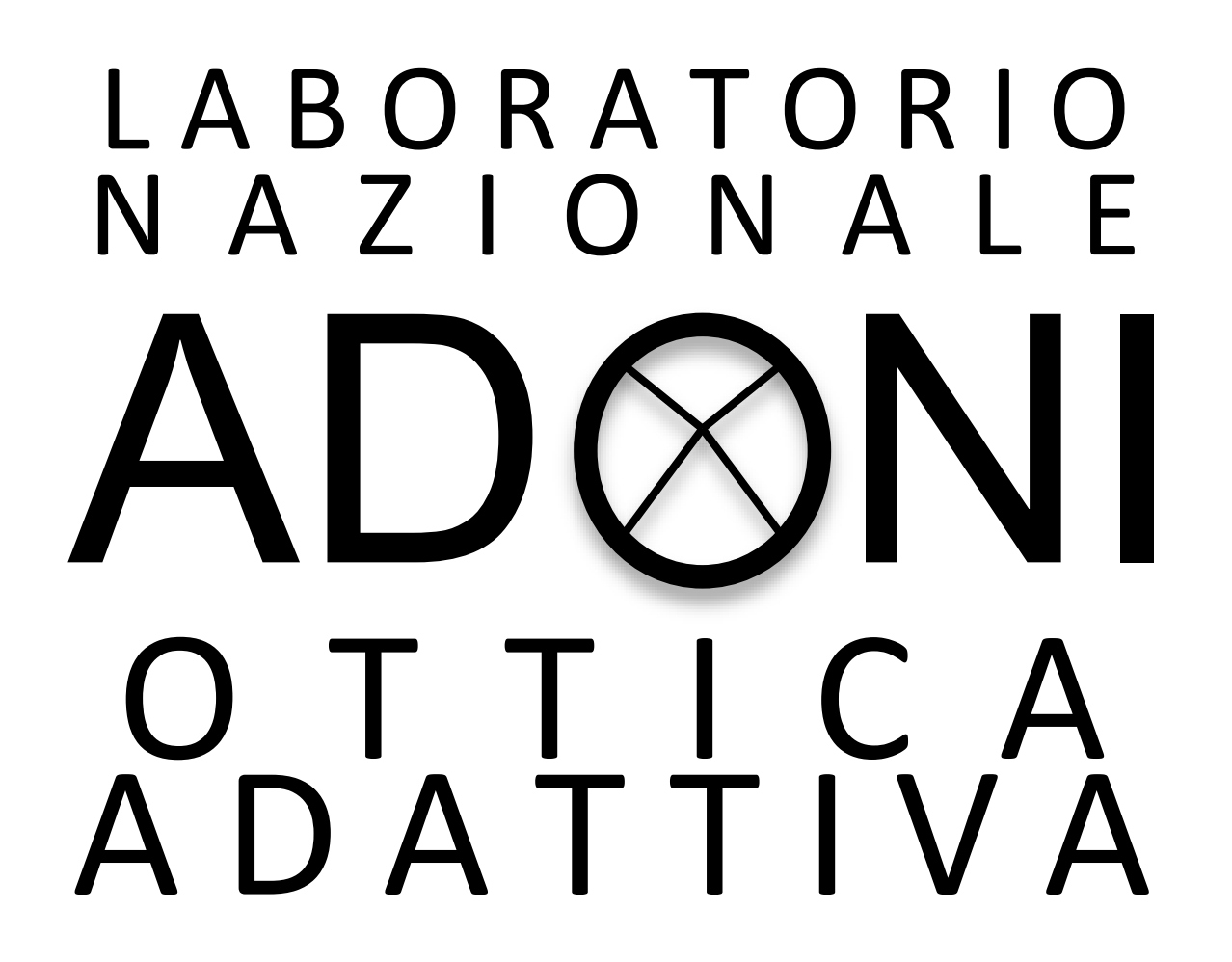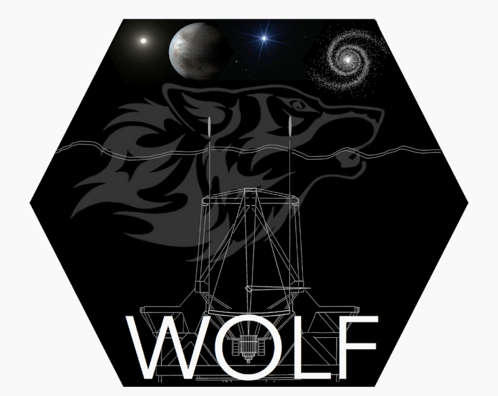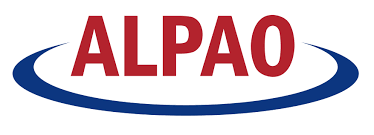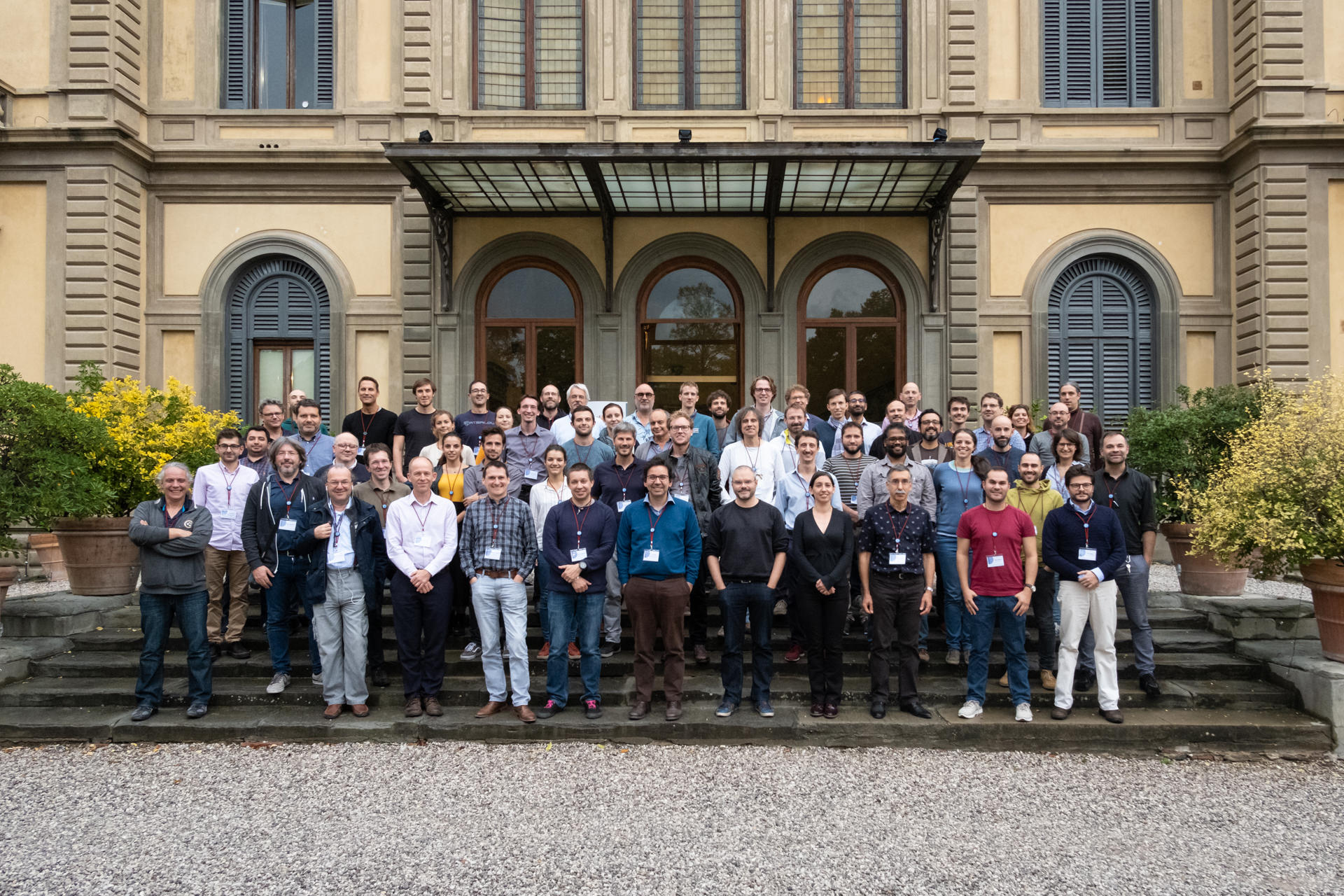Wavefront sensing in the VLT/ELT era, 4th edition
Firenze, Palazzo dei Congressi
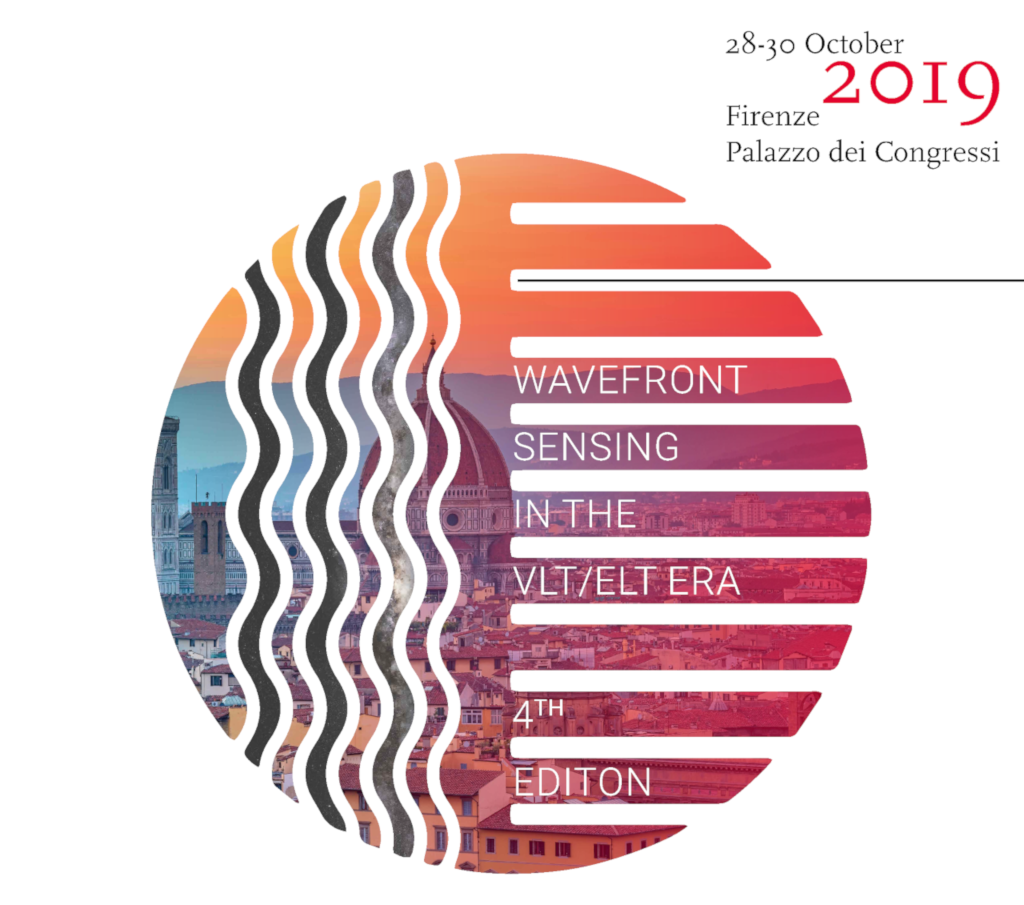
WaveFront Sensing is at the heart, and a key component, of an Adaptive Optics system and often it dictates the ultimate capabilities of the latter, especially in the astronomical domain.
The new challenges dictated by the development of some science field, like the exo-planets detection and characterization, pushed the development of these devices, along with new opportunities coming from new generation of instrumentations for 8m class telescopes and the construction of a next generation of Extremely Large Telescopes.
The workshop will be held in Palazzo dei Congressi.


-
-
12:00
→
13:00
Registration 1h
-
13:00
→
14:00
Lunch 1h
-
14:00
→
14:10
Welcome
-
14:10
→
14:30
The self-coherent camera temporally modulated: a satisfactory paradox 20m
The self-coherence camera (SCC) wavefront sensor exploits efficiently the coherence of light for active correction of quasi-static speckles and for data post-processing. Many attempts have been made over years to improve the potential of the sensor for active optics, fine cophasing optics, and more recently as a support to adaptive optics. The requirements on the optical beam footprint to illuminate the SCC reference channel and fringes sampling in the coronagraphic image usually make difficult its implementation in existing setups, and precludes the correction of fast-living residual atmospheric aberrations. An upgrade of the SCC, called the fast-modulated SCC, where the reference channel creating the interferences in the coronagraphic image is placed close to the pupil boundary, and modulated temporally, solves these original shortcomings. A review of the concept state-of-the-art will be given and the fast-modulated SCC presented. The fast-modulated SCC represents a complete game changer for the sensor: full compatibility with any type of coronagraph, easy installation in existing high-contrast instruments and testbeds, and versatility by accessing short- and long-time exposure measurements and applications.
Speaker: Dr Patrice Martinez (Laboratoire Lagrange ) -
14:30
→
14:50
Seeking for the ultimate wavefront sensor - Probing the free-parameters space of Fourier-based wavefront sensors with the LOOPS v2.0 testbed. 20m
Linearity, sensitivity and dynamic are the trinity of adaptive optics (AO). A wavefront sensor excelling in both these three domains is the Holy Grail for AO scientists. The first integrations of Fourier-based wavefront sensors (F-WFS, like Zernike, Pyramid, etc.) in AO systems show that these devices are capable of high performances and are therefore establishing themselves as the new standard. They are as well very modular objects that can be tuned to improve their functioning regime regarding linearity, sensitivity and dynamic. In order to develop our knowledge, deliver the best performances from AO systems and propose new insights on F-WFS, we developed the versatile AO testbed called LOOPS. On this bench we can now control: (1) the phase of the Fourier filtering mask in the focal plane, allowing to produce any flavor of WFS (3-faced, 4-faced, n-faced pyramids / Ingot / axicone / Zernike / iQuad etc.) (2) the turbulence in the pupil plane, allowing to reproduce several observing conditions (r0, wind speed, power spectral density) (3) the tip-tilt modulation in the pupil plane, allowing to modulate the PWFS in the classical way or produce arbitrary shaped objects like elongated LGS spots Using data obtained from the bench, we present a complete and clear static comparison of different F-WFS in terms of linearity, sensitivity and dynamic. In a second time, we show the performances of the chosen F-WFS in closed-loop operation in terms of bootstrap and residuals RMS capacities.
Speaker: Dr Pierre Janin-Potiron (ONERA / LAM ) -
14:50
→
15:10
The NGS AO system for GMT: performance analysis and simulations 20m
In this talk we will present an update on the performance analysis of the Natural Guide-star Adaptive Optics (NGAO) system for the Giant Magellan Telescope (GMT). The NGAO mode uses a visible-light pyramid WFS (PWFS) with 92x92 subapertures for wavefront sensing, and the Adaptive Secondary Mirror (ASM) with ~4700 actuators for wavefront correction. When using a bright star (R<10) and under median seeing conditions (0.63†at 500 nm), the NGAO system shall provide a Strehl Ratio better than 75% in K band, PSF contrast better than 10^5 at 127 mas (4l/D) in L band, and a segment piston error less than 45 nm RMS. The NGAO system will drive the correction of atmospheric turbulence and M1 segment errors (either segment rigid body motion or figure) with the matching ASM segments, leading to a corrected WF on axis, but generating off-axis field-dependent aberrations. In particular, a tilt on an M1 segment compensated by a tilt on the matching M2 segment will produce a field-dependent segment piston error. We will show through end-to-end Integrated Modeling simulations how off-axis wavefront measurements provided by the Acquisition Guiding and Wavefront Sensing (AGWS) unit are used to solve for this problem and guarantee a good correction over the scientific field of view (20†x 20â€) only limited by atmospheric anisoplanatism.
Speaker: Dr Fernando Quiros-Pacheco (GMTO) -
15:10
→
15:30
MAORY LGS WFS trade-off study: Dealing with the Impact of truncation using regularization. 20m
MAORY is the Laser Guide Star (LGS) Multi Conjugated Adaptive Optics (MCAO) module of ESO’s ELT that will provide a corrected field of view (FOV) of 1 arcminute. The project is in its Preliminary Design Study phase. We present the results of a trade-off study where we analyze the impact of design choices of the LGS WFS on MCAO performance and robustness. We use for that the FRIM+OCTOPUS end-to-end simulation tool. We focus on the design trade-off of a classical Shack-Hartmann WFS, addressing in particular the choice of the pixel scale and subaperture FOVand study the impact of spot size and spot truncation on both the Photon and Read out noise propagation and static bias of slopes. We show that using careful regularization and some other simple algorithmic tricks permit to deal with this problem is a simple and robust way. The performance is then studied for a set of typical CN2 and Na profile conditions and some and recommendations are drawn.
Speaker: Dr Christophe Vérinaud (ESO) -
15:30
→
15:50
A high order pyramid WFS AO system for DAG, the new 4-m Turkish telescope: progress report 20m
An adaptive optics system for the future 4-m Turkish telescope, to be installed in Estearn Anatolia, is being developed. It uses a pyramid WFS with a no noise NUVU camera, allowing a relaxation of the pyramid prism manufacturing tolerances. The deformable mirror is a high order high stroke 468 actuators mirror from ALPAO. Coupling the two technologies allows us to maximise the correction efficiency for any turbulence and guide star conditions, significantely increasing the envelope of the Strehl correction for each guide star magnitude. In K-band, we will be able, in the median seeing conditions of the site (0.9") to run the system in extreme-AO mode, allowing stellar coronagraphy. We are also studying the option to implement a simple machine learning algorithm for the AO control. In this project progress presentation, we will show the final optical design, the preliminary measurements we with the P-WFS, and the first tests with the DM-468 at ALPAO premises.
Speaker: Prof. Laurent Jolissaint (University of Applied Science Western Switzerland ) -
15:50
→
16:20
Coffee Break 30m
-
16:20
→
16:40
Maximum Likelihood Co-Phasing of Large Segmented Mirrors under Turbulence with a Pyramid 20m
We demonstrate numerically the complete co-phasing of a 39-meter primary segmented mirror consisting of 798 hexagonal segments in R/V- and H/I/J-bands. The segments are initially misaligned with a Gaussian random distribution of piston/tip/tilt causing inter-segment phase steps of 5.5 waves RMS. We take into account the obscuration by the six spider vanes of the ELT, each 530mm wide. We simulate the signal from a modulated pyramid wavefront sensor (PWFS) when imaging the pupil of the telescope in monochromatic light, using discrete 2D Fourier transforms. The PWFS can measure segment tip/tilt inside the hexagons and the inter-segment steps in the middle of each of the 2262 edges. The pyramid phase step response function is not strongly seeing-dependent and resembles a single peak which is easier to resolve and process than that of e.g. the phase contrast WFS which has an oscillating shape. By contrast to the Shack-Hartmann WFS, the segment edge registration does not strongly rely on accurate optical alignment and can be done digitally during postprocessing. We model four separate narrow-band exposures of starlight for 30--50 seconds each whose results are compared to determine a set of most likely step solutions for each edge. We then employ maximum likelihood techniques to further filter the solutions and finally the Generalized Least Squares method, optimally exploiting the redundancies of the segment geometry. The residual RMS wavefront error of the phased mirror is below 1/30th of a wave.
Speaker: Mr Ronald Holzlöhner (ESO) -
16:40
→
17:00
Use of a modulation camera to control Fourier-filtering wavefront sensors measurements on the fly 20m
Fourier-filtering wavefront sensors (FFWFS) have demonstrated to be a really promising class of wavefront-sensors exhibiting highly sensitive elements (Zernike WFS, Pyramid WFS, etc…) while providing an exxtreme modularity which allows to use them for different purposes by changing the shape of their filtering masks (Ingot WFS). Now that they have strongly captured the interest of AO scientists, one of their major limitations has to be handled: their non-linear behaviour which degrades performance in closed loop operation. One way to deal with this aspect is to consider the FFWFS as linear-parameter varying systems, which means that they are working in a linear regime which changes at each iteration. We need to determine the so-called Optical Gains in order to track this linearity change through the loop and update the reconstructor accordingly. To achieve this goal, we propose the use of a modulation camera (a camera located after the modulation mirror which takes images of the PSF through one cycle of modulation) to probe the working regime of the FFWFS at any moment. We demonstrate that the knowledge of the modulated PSF combined with a convolutional description of the FFWFS can give us a real-time estimation of the Optical Gains. This innovative way to control FFWFS measurements has to be thought as one among several possibilities to track Optical Gains at each frame. Implementing such “on the fly†feedback solutions in the AO loop appears to be a fundamental step to reach the full potential of FFWFS.
Speaker: Mr Vincent Chambouleyron (Laboratoire d'Astrophysique de Marseille ) -
17:00
→
17:20
Continuous-wave lidar method 20m
AO systems that sense focus using a LGS wavefront sensor cannot distinguish, in the signal received, between changes in atmospheric focus and changes of the sodium layer centroid altitude. Changes in the sodium centroid are falsely perceived as focus term changes, inducing wavefront errors that are proportional to the square of the telescope diameter. The continuous-wave lidar method yields line-of-sight sodium density profiles, derived from LGS by means of fast amplitude modulation of a continuous-wave laser. This method will be presented and a prediction of its performance on extremely-large telescopes will be given. An outlook on its application to existing or planned LGS-AO systems will be discussed.
Speaker: Mr Joschua Hellemeier (UBC/ESO) -
17:20
→
18:00
Session 1: "Open challenges and new ideas in wavefront sensing"
-
12:00
→
13:00
-
-
09:00
→
09:20
ELT Working Group: Preparing Observations 20m
Preparing for ELT Observations In order to get the best out of the future giant ELT, ESO is setting Working Groups that would address (and hopefully optimise) the ELT observations. Toward this objective, (preparing for ELT observations), four WG will be working on: Star catalogues, AO performance and PSF, instrument simulators and ETC preparation. In this presentation, we will present the work that will be carried under the second item: AO performance and simulated PSF. The AO performance of the ELT significantly depends on the available natural guide stars. In each of the observing modes (e.g SCAO, MCAO, LTAO), the brightness of the NGSs, their asterism, and distance from the science target will give significantly different AO performance (quantified by e.g Strehl ratio [SR] or Engircled Energy [EE]). The aim of this WP are: (1) to define an algorithm capable of choosing the best combination of star(s) available in the field of view (provided by the Star Catalogues WG) to give the best AO performance, and (2) generate the Point Spread Function (PSF) expected for the observation for a given observing mode and a given set of environmental conditions (e.g. seeing, Cn2, etc.). I’ll present the state of the art (what’s already available), and the strategy (what do we have to do) to fill this task. Comments from the community will obviously be welcomed…
Speaker: Mr Benoit Neichel (LAM) -
09:20
→
09:40
Online Identification of key-parameters for synthetic-based calibration with Pyramid WFS 20m
The AO instruments of the future ESO-Extremely Large Telescope (ELT) will all include Pyramid Wave-Front Sensor (PWFS) in their design as these WFS provide a gain in sensitivity with respect to the more common Shack Hartmann WFS (SH-WFS). This gain in performance comes with a cost in terms of operational complexity. The PWFS appears indeed to be highly non-linear with a response that depends on the level of AO correction itself, the so-called optical gains of the PWFS. Coupled to this very first technical challenge, the ESO-ELT will provide a challenging environment for the AO calibration with a large number of degrees of freedom, that will have to be calibrated without any external calibration source and unprecedented distances between Deformable Mirror (DM) and AO instruments. Regular evolution of the DM-WFS registration (Rotation, shifts or other anamorphosis of the DM actuators grid with respect to the WFS subapertures) are thus to be expected during the operations. These mis-registrations have to be monitored and compensated as they will highly affect the AO performance or lead to loop instability. To tackle these operational challenges, we propose to consider a pseudo-synthetic approach where calibration data are generated from a synthetic model which parameters are identified from experimental inputs using a mis-registration identification algorithm. We investigated two different strategies to retrieve the signals required by the algorithm: an invasive approach, where specific signals are applied over the DM commands during the operations and a non-invasive approach, where a noisy interaction matrix is estimated from closed-loop data and used to retrieve the mis-registration parameters. In this study, we analyze the accuracy and limitations of both methods, taking in consideration the specificities of the PWFS.
Speaker: Dr Cedric Taissir Heritier (LAM - ONERA - ESO - INAF ) -
09:40
→
10:00
On-sky experiments using CANARY SCAO with point-diffraction interferometers: CAWS & iMZ 20m
Wavefront sensing using interferometery to directly measure the phase has been a goal for many years, since it directly measures the observable and so can provide measurements regardless of defects such as vortices or disconnected apertures. A compelling class of such sensors are the point-diffraction interferometers and this paper presents two implementations; the Complex Amplitude WFS (CAWS; CfAI, Durham) and the Integrated Mach-Zehnder (iMZ; CRAL, Lyon). In particular, the results of their first on-sky tests in the visible behind the CANARY AO experiment in July/2019 at the 4.2m William Herschel Telescope are discussed. Implementation challenges for both WFSs are described and initial results are presented using both monochromatic and polychromatic light, measuring static aberrations and on-sky AO residuals. In the context of the experimental conditions, we highlight the successes and how these suggest future implementations for future experiments.
Speaker: Dr Nazim Bharmal (CfAI, Durham Uni.) -
10:00
→
10:20
Wavefront Phase Imaging sensor (WFPI) 20m
We will discuss here the applications of the Wavefront Phase Imaging sensor (WFPI) on Adaptive Optics (AO) for Astronomy. The WFPI sensor is based on registering the intensity distribution at two different optical planes by a conventional imaging sensor. In the geometrical approximation, the light can be considered as a collection of light rays which bends according to Snell’s law. In the context of this approximation, with boundary conditions, and using the probability density function of photons, we calculate the photon displacement between both intensity images and the associated wavefront slope. Our results using WFPI sensor show high resolution wavefront maps, real time working, high dynamic range, and improved repeatability and reproducibility related to classical wavefront sensors. It is currently being used in a variety of demanding fields as silicon metrology, optical characterization, and ocular laser surgery. Extreme AO, co-phasing, and MCAO are suitable applications of the WFPI sensor.
Speaker: Dr José Manuel Rodríguez-Ramos (Universidad de La Laguna (Wooptix)) -
10:20
→
10:40
Temporal behavior of a low-order MCAO loop 20m
Future tomographic Adaptive Optics (AO) systems have strong requirements in terms of sky coverage. A study of the latter is then important for the conceptual design. However, running end-to-end simulations for a representative set of Natural Guide Star (NGS) asterisms is not feasible with standard hardware resources. It is thus necessary to assess the part of the error budget that is related to sky coverage, i. e. the Low Orders (LO), in a much faster way. While this exercise is quite easy in an AO system using only one NGS, the tomographic LO estimation and correction has not been studied thoroughly yet. The goal of the presented work is to analytically compute a temporal power spectral density of the residuals from a LO MCAO loop along any line of sight, given a turbulence/wind profile and a noise level from the NGS sensors. This will allow a fast exploration of the sensitivity of the NGS sensors to different noise and turbulence conditions, as well as an easier optimization of the LO loop control.
Speaker: Cedric Antoine Adrien Gabriel Plantet (Istituto Nazionale di Astrofisica (INAF)) -
10:40
→
11:10
Coffee Break 30m
-
11:10
→
11:30
SOUL Modal Gain Machine 20m
SOUL has been developed to improve LBT FLAO performance reducing detector noise and increasing wavefront sampling and correction frame rate, but an accurate optimization of the control system is required to fully exploit its potential. Thus, an online modal control optimization has been designed and implemented considering the peculiarities of the Pyramid Wavefront Sensor. We will describe the method used with particular attention to the aspect related to the Pyramid WFS and report laboratory and on-sky results from the commisioning of SOUL.
Speaker: Guido Agapito (Istituto Nazionale di Astrofisica (INAF)) -
11:30
→
11:50
Preliminary design of the MAORY Calibration and Test Unit 20m
MAORY (Multi-conjugate Adaptive Optics RelaY) is one of the first light instruments for the Extremely Large Telescope (ELT). It will be firstly used by MICADO (Multi-AO Imaging CamerA for Deep Observations), a near-infrared high-angular resolution imager, to compensate aberrations and provide high-Strehl images within a (53â€x53â€) Field of View (FoV). The complexity of MAORY requires calibration functionalities for both the AIV (Assembly-Integration-Verification) and the operational phase. The function of the Calibration and Test Unit (CTU) is keeping the high efficiency of the adaptive correction provided by MAORY during the operational phase, through proper calibration sources, acting as both Natural Guide Stars (NGS) and Laser Guide Stars (LGS) sources. A recent review of the MAORY optical design has involved a deep change in both the concept and the position of the CTU, with respect to the original concept: an overview of the old design, the status of the new design and the main challenges to face in the future are presented.
Speaker: Mr Ivan Di Antonio (Università di Roma Tor Vergata - INAF) -
11:50
→
12:10
The laboratory characterization of the SHARK-NIR Adaptive Optics channel 20m
The typical coronagraphy contrast needed to reveal a giant planet from the ground is of the order of 10-5 - 10-6. These numbers can be reached with coronagraphy techniques like the Apodized Pupil Lyot, the Shaped Pupil, and the Four Quadrant Phase Mask coronagraphs, all methods that require Adaptive Optics (AO) systems to retrieve high quality wavefronts. SHARK-NIR is the camera for the Large Binocular Telescope (LBT) designed to use these coronagraphic techniques, and to be interfaced to the telescope in a strategic position, in order to exploit the already corrected wavefront from the LBT adaptive secondary mirror. For SHARK-NIR, the requirement on the wavefront quality is about 60 nm, plus the correction of the Non Common Path Aberrations (NCPA). For this reason, SHARK-NIR hosts an inner AO channel with two different scopes: correct the telescope jitter (to reach 3-5 mas for the tip-tilt) and reduce the NCPA under the 30 nm threshold. The NCPA characterization will be performed using Phase Diversity, with the scientific detector plus a deployable lens together acting as wavefront sensor. SHARK-NIR is now in its AIV phase at INAF-OAPD laboratories, where an intense characterization of the components is in progress before the integration. Here we present the results of the performance of the TT-loop and of the hardware components of the SHARK-NIR AO channel, the capability of the system to correct the NCPA, and finally the laboratory tests to tune the parameters of the Phase Diversity software.
Speaker: Federico Biondi (INAF-OAPadova) -
12:10
→
12:30
Modulation strategies to mitigate island effect with the pyramid wavefront sensor 20m
The pyramid wavefront sensor is so far the most appropriate design for adaptive optics systems in the context of the Extremely Large Telescope. However, island effect has been identified as a critical issue: the presence of a six legged 50cm-wide spider supporting the secondary mirror breaks the spatial continuity of the incoming wavefront. It is therefore necessary to measure the gap, aka differential piston, present between each petal in order to reconstruct a continuous wavefront. We show that a modulated pyramid in the visible, on an ELT and under partial turbulence correction is not suitable for differential piston measurement: residual phase errors are read as a non-zero differential piston signal for zero piston error, leading to diverging petal pistons. We propose and study different modulation strategies which combine the benefits from the modulated, linear regime on one hand for a good atmospheric turbulence correction and the unmodulated, diffractive regime on the other hand for a better differential piston measurement.
Speaker: Ms Arielle Bertrou-Cantou (LESIA) -
12:30
→
12:50
The Adaptive Optics Module of MAVIS: preliminary design and trade-offs 20m
The Adaptive Optics Module (AOM) of MAVIS consists in a MCAO system aimed to deliver a corrected visible field of view to the MAVIS imager and spectrograph. The module takes advantage of the ESO VLT UT4 Adaptive Optics Facility, including the telescope deformable secondary mirror and the laser guide stars lauching and control systems. The preliminary design of the AOM required a number of trade-offs, carried on during the early Phase-A of MAVIS project. These include also the selection of the best suitable solutions at conceptual system level, aiming, as much as possible, at a no-compromise approach in terms of system performances, especially referring to sky coverage, which is known to be a critical aspect for MAVIS science cases. In this framework, I will present the current status of the AOM design and will report on how some science and opto-mechanical trade-offs, which required dedicated analysis and simulations, impact the system parameters and the AO performance estimations.
Speaker: Valentina Viotto (Istituto Nazionale di Astrofisica (INAF)) -
12:50
→
13:10
Flattened pyramid & oscillating sensitivity 20m
By decreasing the apex angle of the Pyramid Wave Front Sensor (PWFS), the four pupil images on the detector are getting closer and closer. Below a certain angle, these images even overlap. Although this optical configuration is an obstacle to understand the PWFS output as the slopes of the phase, the so-called Flattened PWFS turns out to be an high-performance sensor. Its benefits are indeed manifold: as the PWFS, it is tolerant regarding to the spectrum of the source. Morever, it requires far less pixels than the large angle Pyramid to measure the wave front; making this sensor very efficient in terms of photon use. Last but not least, the FPWFS exhibits enhanced sensitivy on some spatial frequencies ranges. The location of these ones intimately depend on the apex angle of the pyramid and seems to be periodic wrt to the spatial frequencies. Although this peculiar behavior is observed in numerical simulations and on exprimental setup, this phenomenon still suffers from a lack of theoretical understanding. In this talk, we introduce a simple analytical model which decribes the pyramid sensitivity depending on the modulation radius and the apex angle. This approach explains the oscillations observed in the sensitivity shape as well as the high-performance of the FPWFS. It also allows to elucidate the significant difference in terms of sensitivity of the classical and the flattened pyramids. Finally, we show that this model allows to predict the behavior of a sensor combining small angle and tip/tilt modulation.
Speaker: Mr Olivier Fauvarque (Laboratoire d'Astrophysique de Marseille) -
13:10
→
14:10
Lunch 1h
-
14:10
→
14:30
Lightning and thunder: a wavefront sensor suitable for a jupiter-like planetary disk 20m
One of the most spread results from MAD has been a set of pictures of Jupiter made using two satellites as references. This inspired some time ago a concept of a dedicated wavefront sensor for planetary disks. We resurface such a concept with variations to make it very efficient, using some of the dark wavefront sensing concepts, and implementing it in a layer oriented fashion.
Speaker: Roberto Ragazzoni (Istituto Nazionale di Astrofisica (INAF)) -
14:30
→
14:50
Image Recognition for NCPA mitigation 20m
The Non-Common Path Aberrations (NCPA) represent a non-negligible issue that degrades the performances of every high-resolution AO-assisted imager working at visible or near infrared wavelengths. We present an innovative technique for the NCPA mitigation, which we are developing in the framework of SHARK-VIS at LBT, where it is usually attained through a trial-error or phase-diversity approach. The proposed method is based on the use of a neural network for image recognition. This new technique is a promising way to directly measure the NCPA so that it can be corrected with the injection of an "aberration" offset into the AO system. In our approach, the neural network used to measure the NCPA is trained through an ad-hoc set of aberrated extrafocal PSF simulations, where a PCA analysis is used to optimize the dimension of the original data set for the classification purpose. The first steps of this study will be presented, discussing the potential and the drawbacks of this new method.
Speaker: Mr Alessandro Terreri (INF-AOR) -
14:50
→
15:50
Session 1: E-ELT and wavefront sensing (Overview/Discussion Jason Spyromilio)
-
15:50
→
16:20
Coffee Break 30m
-
16:20
→
16:40
Focal plane wavefront measurement with convolutional neural networks 20m
Historically, fully connected neural networks were first investigated and have showed some successful results. The lack of generalization power and the poor scaling of the networks ultimately limited the achievable performances. Higher computational power and more complex architectures promise increased performance, flexibility and robustness that have yet to be exploited. In this contribution, we explore the use of convolution neural networks to perform image-based wavefront sensing. We focus on low to moderately aberrated regimes of about 0.15 - 1 rad RMS wavefront error. Based on simulations, we test different state-of-the-art CNN architectures on two different types of data sets, one with only low order aberrations (20 Zernike modes) and one including higher order modes (100 Zernike modes). We discuss the accuracy reached in both cases, and we show that the direct phase map reconstruction outperforms the classical machine learning modal approaches. The precision achieved is approximately 1 to 10% (depending on the case considered) of the injected wavefront. We shortly explore the impact of phase diversity, and we compare our optimized CNN model to a standard iterative phase retrieval algorithm. Finally, we test our method to post-coronagraphic PSFs, i.e. behind a vortex phase mask, and compare it to the classical PSF case.
Speaker: Gilles Orban de Xivry (Université de Liège ) -
16:40
→
17:00
Robust wavefront sensing in harsh turbulence conditions 20m
The ultimate performance of adaptive optics is limited by the quality of the wavefront sensing. This is particularly the case when the turbulence is faster or stronger than the medium conditions assumed in the design of the system, or in case of low signal to noise ratio (e.g. low flux). In such extreme conditions, some general parameters of the system, like modal gains, can be tuned at minute scale. But the turbulent wavefronts rapidly evolve in time (e.g. turbulence bursts) and space (variations across a large pupil). The algorithms we have developed for such harsh conditions rely on the estimation of the error associated with each wavefront sensor measurement, including the covariance of the errors. This information allows the control loop to promptly optimize itself to fast varying conditions. An overview of the wavefront sensing algorithms in charge of implementing this strategy will be presented, with the constraint to fit in a current multi-core CPU. The method is demonstrated on streams of data obtained on THEMIS solar telescope in the visible, where the images of solar granulation given by the subapertures of the Shack-Hartmann wavefront sensor get randomly blurred, some of them possibly fading away. The structure of the noise shows correlations of the gradients similar to the ones induced by laser guide stars elongationn on an ELT.
Speaker: Dr Michel Tallon (Univ Lyon, Univ Lyon1, Ens de Lyon, CNRS, Centre de Recherche Astrophysique de Lyon UMR5574, F-69230, Saint-Genis-Laval, France) -
17:00
→
17:20
Automatic Beam Stabilization for SHARK-VIS 20m
The results obtained from the first SHARK-VIS forerunner experiment have clearly shown that, despite the very good performances reached by the extreme-AO system of LBT, a beam stabilization system is required in order to reduce the residual jitter at the instrument, which is mandatory to improve image contrast in long exposure and coronagraphic observations. Driven by this requirement we developed a closed loop system, called Automatic Beam Stabilization (ABS), that runs at a frequency of up to 1 kHz. The ABS is based on a reactive piezo tip/tilt mirror and a fast low-noise sCMOS camera that are controlled by a commercial workstation implementing a forecasting algorithm to achieve PSF stability. In this talk we present the system architecture and discuss our promising laboratory test results as well as next implementation.
Speaker: Massimiliano Mattioli (Istituto Nazionale di Astrofisica (INAF)) -
17:20
→
17:40
Simulation Environment for Segment and Petal Phasing of Large Telescopes 20m
Pupil fragmentation, also known as the island effect, poses a serious problem for adaptive optics in large telescope. If the petals of a segmented mirror are aligned so that they overlap with the spider vanes, as is e.g. the case with the six petals of the adaptive M4 in the ELT, phase discontinuities between neighboring petals can become difficult to detect reliably. Moreover, radiative subcooling of the spider vanes against the night sky can give rise to wakes of cold air on the downwind side of the spider trusses, causing asymmetric spider seeing that induces additional phase steps between the pupil sectors (sometimes called “low-wind effect”). Currently, several approaches are under investigation to measure the phase steps using wavefront sensors (WFS) in K-band (2200nm) where Fried’s length r0 can exceed the spider width d (in the ELT, d = 530 mm).
In this work, we present a numerical simulation environment for segment and petal phasing of large telescopes. In order to highlight its capabilities, we study a lateral shearing WFS to sense pupil fragmentation in K-band. To accurately measure the phase step across all spider vanes on a single detector of minimal size, we consider a shearing mask in which the pie slice shaped pupil region around each spider vane is sheared perpendicular to the vane by the distance 1.5—2 d. The total shearing pattern is thus reminiscent of a windmill. We find that the petal phase step can be measured by averaging the irradiance along the central corridor of width 0.5--1 d where the petals left and right of the spider overlap after shearing. The response function and achievable sensitivity are compared to that of a pyramid WFS and a phase contrast WFS. The shear mask could e.g. consist of a glass plate with six sets of gratings, each aligned with one of the spider vanes. The gratings are optimized to suppress all diffraction orders except +1 and -1 and the lateral shearing distance can be tuned by pistoning the grating plate vs. the detector.
Speaker: Mr Ronald Holzlöhner (ESO) -
17:40
→
18:00
The Phasing and Diagnostic Station in the ELT 20m
The phasing and diagnostic station (PDS) at the ELT brings the telescope after the installation of mirrors to diffraction limited performance and into operational configuration for science by verifying telescope performance in relevant areas within the acceptance range of the PDS. It also enables to phase and optically diagnose the telescope throughout its lifetime. We report on the technical aspects of this tool and the systems engineering process that has resulted in the current status. We carried out an architectural trade-off study, with functional analysis and needs from the users as input, and selected a conceptual architecture baseline for the preliminary design phase.
Speaker: Thomas Pfrommer (ESO) -
20:00
→
22:30
Social dinner 2h 30m
-
09:00
→
09:20
-
-
09:00
→
09:20
One laser, two LGS for two WFS: technology, on-sky demonstration and first results 20m
MAVIS (MCAO-Assisted Visible Imager & Spectrograph) answers the ESO proposal for a new instrument to equip UT4 at the Paranal Observatory, using the available Adaptive Optics Facility (4LGSF and DSM). It is developed within an Australian-European consortium, leaded by Australia. MAVIS shall deliver near-diffraction limited image quality in the visible over a field-of-view of 30"x30". To reach such a challenging goal, the simulations conducted during the ongoing phase A study of MAVIS have shown that a minimum of six LGS/WFS will be needed to achieve the required correction over the large scientific field-of-view. The cost and technological complexity associated to adding two or even four lasers on UT4 have led the team to look for alternative solutions, by possibly splitting the existing lasers in order to create two LGS. The statistical analysis of two years of flux return in the WFS of GALACSI has shown that splitting the lasers should still deliver enough photons for MAVIS. Technical solutions to create two LGS from one laser have then be looked for, and Diffractive Optical Elements (DOE) have been identified as a cheap and simple solution fulfilling the requirements. An off-the-shelves DOE delivering a separation of 18" on-sky has been procured and tested at the Wendelstein Laser Guide Star Unit experimental facility at La Palma, with the support from IAC. During two nights on September 13th and 14th 2019, on-sky measurements have been conducted to determine the flux balance, the separation, and the differential tip-tilt between the two LGS. This test validated the feasibility of the method and the obtained data will be used for defining the final and optimized DOE for MAVIS.
Speaker: Mr Pierre Haguenauer (ESO) -
09:20
→
09:40
SHARK-NIR, a status update 20m
Exo-Planets search and characterization is a very fast growing astronomical research field and will be one of the most exploited scientific topic in the next decades. Among the exoplanets detecting techniques used nowadays, the direct imaging is probably one of the most challenging from a technological point of view, as it requires the use of complex coronagraphic masks in synergy with exquisite wavefront sensing and data reduction. Currently, only a few coronagraphic instruments are in operations in the Northern Hemisphere, which makes it particularly appealing for new generation high contrast imagers. This scenario led to SHARK-NIR conception and drove its design. SHARK-NIR is a high contrast camera for the LBT, working in Y, J and H bands. It has been conceived and designed to fully exploit the high Strehl adaptive optics correction delivered by the FLAO module, which is being upgraded to SOUL, and will implement different coronagraphic techniques, with contrast as high as 10-6 up to 65 mas from the star. It also has spectroscopical capabilities, with low and medium resolution, and its relatively wide Field of View (18 x 18 arcsec) makes it accessible to other scientific targets, such as galactic jets and disks, as well as extra-galactic cases. SHARK-NIR has a couple of peculiar features, such as a fast internal TT loop to minimize the residual jitter and a local NCPA correction, performed through a DM inside the instrument itself. We report here about the SHARK-NIR status, which is in the AIV phase, that should finish by the spring of the next year, bringing in this way the first photons to the instrument by the end of 2020.
Speaker: Luca Marafatto (Istituto Nazionale di Astrofisica (INAF)) -
09:40
→
10:00
First results on a LGSWFS prototype for the ELT 20m
In this presentation, we introduce the first experimental results obtained with the new C-MORE camera, in order to develop a Laser Guide Star Wave-Front Sensor for the ELT. Indeed, the size of the ELTs is a challenge for LGSWFS, as it calls for large, fast and noise-free detectors. Toward this goal, the new C-MORE camera offers 1100x1100 pixels that can be read at almost 500Hz and with less than 3e- Read-Out-Noise. It also offers a global shutter mode, which reduces the risks on WFSensing. At LAM we have implemented a test bench in order to demonstrate the capabilities of this new device to perform LGS WFSensing. In this presentation, we will first present the electronic tests performance on the camera. We will then report on linearity of the detector, as well as its behavior vs. flux. Plans to upgrade the bench with a 80x80 lenslet array and extended source are also presented. Overall, we find that this device is a very interesting and promising camera to equip the LGSWFS of the ELT, and it is proposed as the baseline for HARMONI.
Speaker: Mr Zibo Ke (LAM) -
10:00
→
10:20
Turbulence parameter estimation with Paranal Observatory wavefront sensors 20m
The ubiquity of Shack-Hartmann wavefront sensors in current observatories makes them interesting tools for atmospheric turbulence parameter estimation. We showed in Andrade et al. 2019 how to derive the Fried parameter and outer scale in a robust way, correcting for cross-coupling (when a Zernike basis is used). In this poster we apply the method to the telemetry of several wavefront sensors at Paranal Observatory: SAXO (SPHERE), NAOMI (VLTI) and CIAO (VLTI). Both open loop and closed loop data are addressed. We find that our results are compatible with simultaneous DIMM measurements. The main difficulties in implementation are highlighted and recommendations for telemetry data curation are made.
Speaker: Mr Paulo Garcia (CENTRA and Universidade do Porto − Faculdade de Engenharia) -
10:20
→
10:40
The Ingot Wavefront Sensor: Optical Design and laboratory tests 20m
The Ingot WFS (I-WFS) is a new pupil-plane wavefront sensor based on the Pyramid, and particularly designed to deal with the typical elongation of the extended nature of the Sodium Laser Guide Star (LGS). It has been designed in the framework of the E-ELT, in the peculiar case of a Laser lunch telescope located outside the telescope pupil. In this paper, we present the current optical design of the 3-faces I-WFS, based on a reflective roof-shaped prism, which is able to split the light, a the level of the focal plane, into three beams. In this design, the vertex of the prism is constrained to the lower edge of the Sodium layer in atmosphere, assumed to be the sharpest one, using the tip-tilt term, usually neglected in case of LGS wavefront sensing. In this framework, it has been made a preliminary analysis on a set of Sodium density profiles data, in order to validate the theoretical assumptions related to the I-WFS design. Three re-imaged telescope pupils are then used for the retrieval of the first derivative of the wavefront. A complete automated procedure, relying solely on the illumination observed at the three pupils, to align the prism to the image of the LGS is discussed. We also present the current status of a test-bench able to reproduce, in a scaled manner, the 3D Sodium illumination that the I-WFS will face at the ELT, in order to prove the design and perform tests of phase retrieval.
Speaker: Dr Simone Di Filippo (Istituto Nazionale d'Astrofisica (INAF) ) -
10:40
→
11:00
Commissioning status of the new NGS WFS for GeMS 20m
GeMS is the multi-conjugate adaptive optics facility in operation at Gemini South since 2013. It uses 5 laser guide stars WFSs and one up to 3 NGSs for low order correction. Recently, the AO facility of GeMS has been upgraded with a new NGS WFS to increase sky coverage, improve efficiency and ease of use. I will present in this talk the concept of NGS2, a focal plane WFS using an EMCCD camera that allows fast readout of small region of interest for TT and plate scale mode corrections. I will then present the benefit of this NGS sensor compared to its previous generation and finally a preliminary comparison and performance assessment obtained with GeMS using NGS2.
Speaker: Benoit Neichel (ONERA) -
11:00
→
11:30
Coffee Break 30m
-
11:30
→
12:30
Session 1: "Workshop summary and open discussion"
-
11:30
Coffee Break 30m
-
11:30
-
12:30
→
13:00
Wrup-up & farewell
-
09:00
→
09:20




